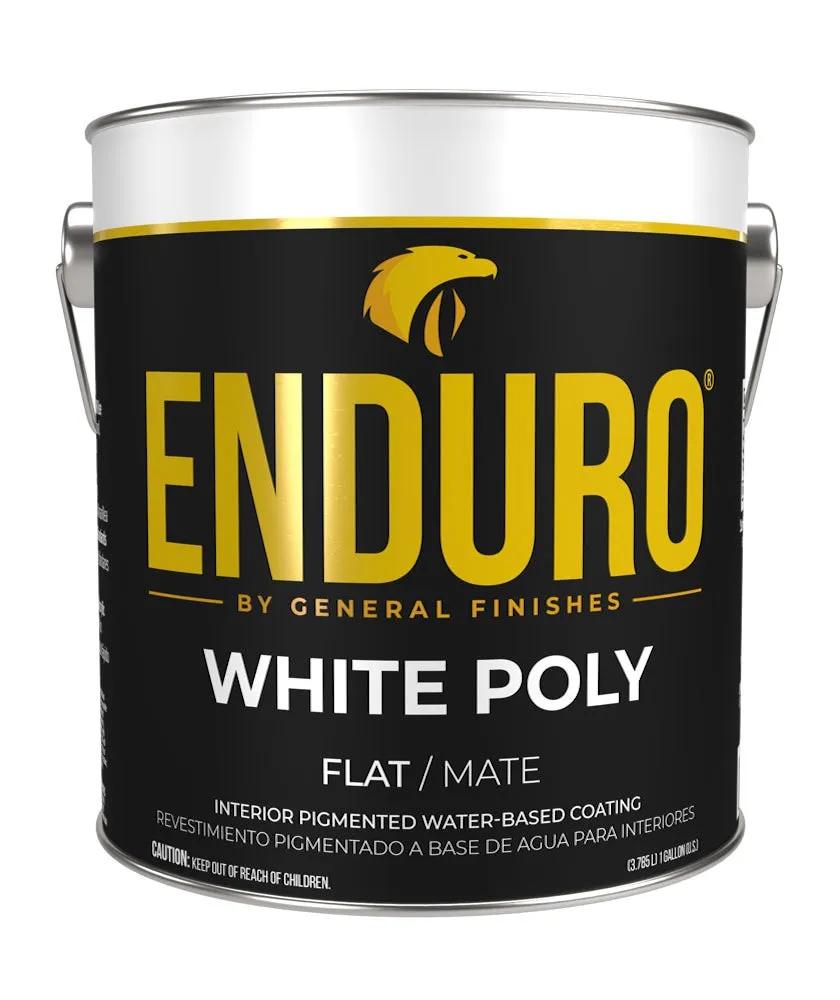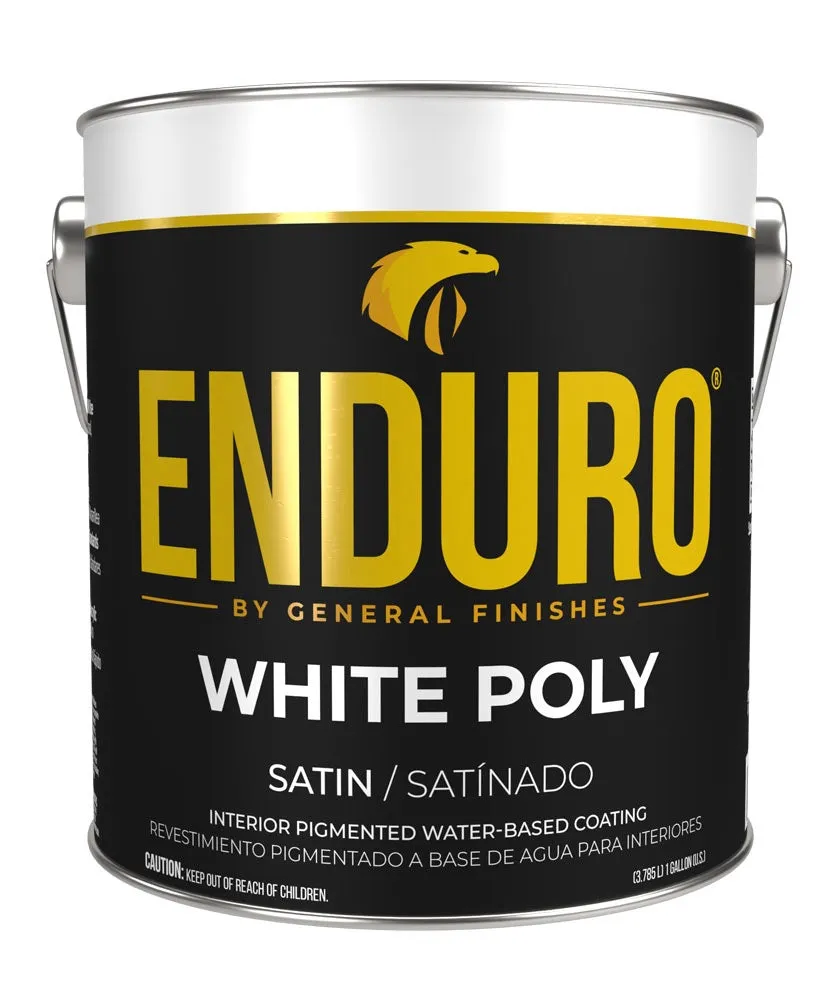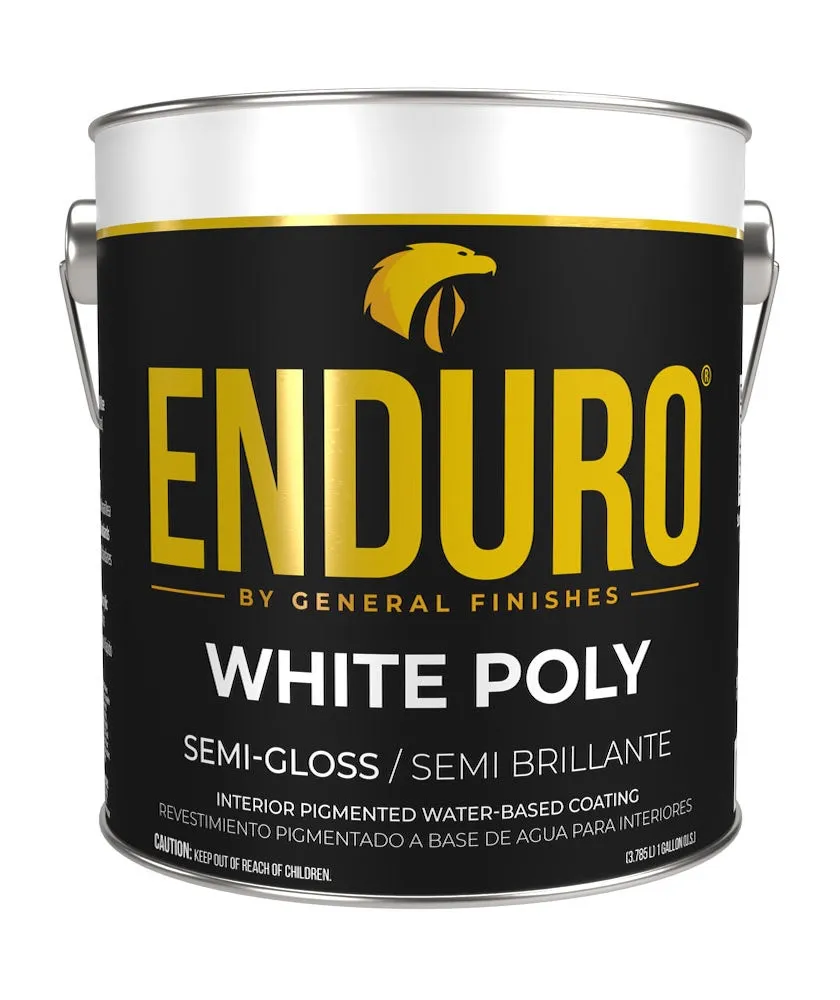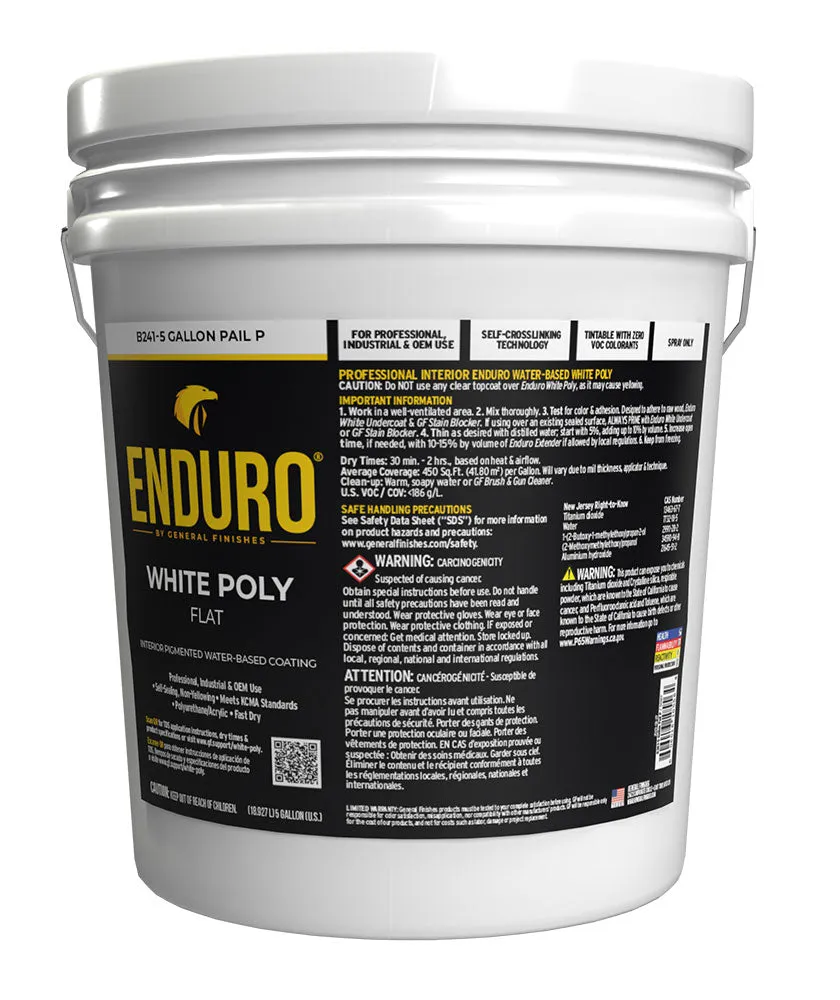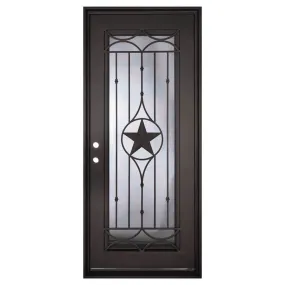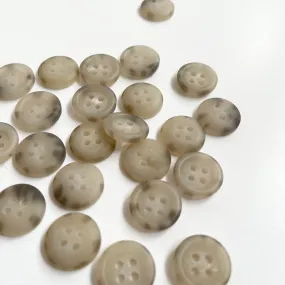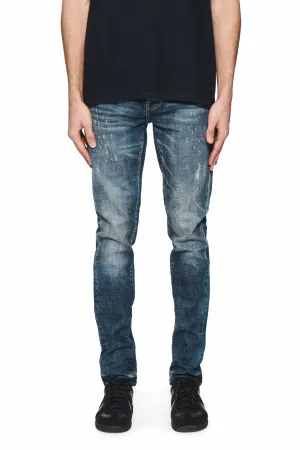Enduro Pigmented White Poly is a high-solids, pigmented water-based wood finish engineered for cabinets and millwork. Use only over General Finishes or . Stocked in Black and White, custom colors are available to wholesale customers upon request. White and Clear can be used as tint bases to achieve endless colors. For non-architectural use.
Please click the below headers to reveal the instructional info for this General Finishes White poly paint product.
Step 1: Preparation for White Poly
All wood projects require preparation sanding, and all existing finishes require prep cleaning and sanding. If you skip this critical step, your finish may fail.
Preparation for Raw Wood or Raw Wood Projects That Are to be Stained
- Sanding Schedule: 120-grit followed by 150- or 220-grit sandpaper.
- Remove dust with a vacuum, compressed air, an oil-free tack cloth or a water-dampened rag.
- Let dry completely before applying GF product.
- Do not over-sand with fine-grit sandpapers; this will close and seal the wood grain, preventing ideal color absorption.
- Do NOT use steel wool with water-based finishes; the particles will get trapped in the finish and rust.
Preparation for Projects with an Existing Finish (Sealed Surface)
For high-use areas with heavy grime build-up and oil from hands, give your project a deeper cleaning.
- Scuff clean with a Scotch Brite™ pad and a 50:50 mix of denatured alcohol and water. Dry 1-2 hours. Avoid cleaning with products containing phosphates (salt), which can linger in the substrate and produce a white haze. If your project requires a deeper cleaning, see Power Prep Cleaning Highly Used Existing Finishes below.
- Sand lightly with a fine-grade (220-320) foam sanding pad.
- Remove dust with a vacuum, compressed air, an oil-free tack cloth or a water-dampened rag.
- Let dry completely before applying General Finishes product.
Power Prep Cleaning Highly Used Existing Finishes
For high-use areas such as kitchen cabinets or table tops with heavy grime build-up and oil from hands, give your project a "Power" clean.
- Scrub clean with a detergent, such as Spic and Span or Dawn, using a Scotch Brite™ pad.
- Rinse well with water.
- Scrub clean with a Scotch Brite™ pad and a 50:50 mix of denatured alcohol and water. Dry 1-2 hours.
- Sand lightly with a fine-grade (220-320) foam sanding pad.
- Remove dust with a vacuum, compressed air, an oil-free tack cloth or a water-dampened rag.
- Let dry completely before applying General Finishes product.
Alternative Cleaning Solutions For Existing Finishes (Not as aggressive or effective as denatured alcohol; requires rinsing.)
- 50:50 mix of bleach and water
- 50:50 mix of vinegar and water
- Mineral spirits can be used when working with water-based products, but only if the surface is thoroughly rinsed and allowed to dry for 72 hours.
- If you use with products containing phosphates (salt), which can linger in the substrate and produce a white haze, be sure to rinse thoroughly.
Step 2: Priming for General Finishes White Poly
CAUTION: Do NOT use any type of clear topcoat over GF , as it may cause yellowing.
CAUTION: General Finishes Enduro White Poly is engineered to adhere well to raw wood, General Finishes and .
When working over raw wood, 2 coats of either or MUST be applied before applying Enduro White Poly to prevent tannin bleed through and ensure a successful outcome. Both work very well but will achieve a slightly brighter sustained white.
When working over an existing finish, 2 coats of Stain Blocker MUST be applied before applying Enduro White Poly to prevent tannin bleed through, improve adhesion and ensure a successful outcome.
- aw Wood Tannin Bleed-Through is unpredictable; yellowing can appear immediately or months later with seasonal temperature changes. Oak, pine, mahogany, and Douglas fir are particularly prone to bleed-through.
- Knots in Wood tend to bleed and are dense, making paint adhesion a challenge. may improve adhesion and prevent bleed-through.
- Existing Finishes Bleed-Through may be caused by wood tannins, previous stains or aniline dyes, surface contamination, and incompatibility between brands. ALWAYS apply 2 coats General Finishes before applying Enduro White Poly over an existing finish for adhesion and to prevent bleed-through.
- Non-Wood Surfaces may be able to take paint if primed first. Primer may improve adhesion over laminate and prevent bleed-through from MDF. Metal requires a primer made specifically for metal. Always test first before completing your entire project.
NOTE: Do not tint or use General Finishes on projects that will be stored outdoors.
Priming Non-Wood Surfaces for Paint
Always test for adhesion on a hidden area of your project before getting started.
Metal: Enduro Pigmented White Poly is engineered for wood surfaces, but may adhere to metal, such as aluminum or steel, if a metal primer is applied first.
- Clean the surface well.
- Apply primer.
- Dry 48-72 hours before painting.
Laminate: Enduro Pigmented White Poly MAY adhere to laminate with a bonding primer; however, we cannot guarantee it. You may increase your chances of success by abrading the surface.
- Prep: Deep clean, dry thoroughly, sand with 150- then 180-grit sandpaper, and wipe off dust.
- Prime: Apply bonding primer, dry 12 hours before painting.
MDF: Enduro Pigmented White Poly can be applied directly to MDF, but the MDF may cast a brown color if not primed first. Two base coats of white-pigmented shellac-based stain-blocking primer, or , may prevent bleed-through. Alternatively, one base coat of General Finishes may block brown tone caused by MDF.
Disclaimer
Although is engineered to prevent the most persistent bleed-through when 2 coats are applied, General Finishes cannot guarantee prevention of bleed-through or yellowing on every project. Unknown factors and assiduous bleed-through can impact results. is the strongest option we are aware of at this time and has performed extremely well in our tests.
Step 3: How To Apply General Finishes White Poly
CAUTION: Do NOT use any type of clear topcoat over GF , as it may cause yellowing.
CAUTION: General Finishes Enduro White Poly is engineered to adhere well to raw wood, General Finishes and .
When working over raw wood, 2 coats of either or MUST be applied before applying Enduro White Poly to prevent tannin bleed through and ensure a successful outcome. Both work very well but will achieve a slightly brighter sustained white.
When working over an existing finish, 2 coats of Stain Blocker MUST be applied before applying Enduro White Poly to prevent tannin bleed through, improve adhesion and ensure a successful outcome.
General Finishes Enduro White Poly Application Steps
- Stir to reincorporate solids that have settled to the bottom of the can before and throughout the application process.
- Thin as desired with distilled water; start with 5%, increase up to 10% by volume.
- Increase open time, if needed, with up to 5% General Finishes Extender if allowed by local regulations. will improve flow and leveling and increase open time, which is helpful in dry climates. California Residents:Adding more than 2% of GF Extender will make the products non-compliant per SCAQMD Regulations. GF assumes no liability for the improper use of these products.
- Apply 3 coats. Additional coats will not improve durability.
- Spray application: Before spraying, strain through a medium-mesh filter. Spray wet films at 3-5-mil thickness. HVLP: 1.3mm-1.5mm spray tip, medium air cap. Verify tip sizes with your equipment supplier. . Keep your gun at a 90° angle,6-8" from the surface. On large, flat areas, use wet, even patterns6-8" wide. For narrow surfaces, reduce the fan pattern to 2-3" wide to reduce overspray. Overlap each pass 25% to conceal lines. Wear a mask and work in a ventilated space.
- Face frames: Enduro professional products are engineered to be spray-only but can be successfully applied successfully to cabinet face frames, edges or drawer fronts with a small cabinet-specific 3/8" nap microfiber roller such as Whizz or AllPro brand. Larger areas may not level with a roller application. Add 10-20% Extender for improved results.
- If a faster build is desired over raw wood, use for the first coat, followed by 2 coats of White Poly.
- Dry time in ideal conditions: 70°F/20°C; 50-70% humidity. Tack free 5-10 minutes. Ready to sand 30-45 minutes. Recoat in 1-2 hours. Be sure to allow adequate dry time. You can tell if a water-based finish is dry if it forms a powder when lightly sanded with a fine-grade (220-320) foam sanding pad. If in doubt, wait longer. Rushing the dry time can cause "blush," which is clouding in the finish due to moisture trapped between the layers. Increase dry time if:
- Humidity is over 80%
- 3 coats are applied
- Thick coats are applied
- Applying over an existing sealed finish
- Applying over products from other brands
- Layering General Finishes water- and oil-based products:
- Water over oil: Let oil-based products dry 72 hr before applying water-based products
- Oil over water: Let water-based products dry 24 hr before applying oil-based products
- To accelerate dry time in humid conditions, add and work in a space with good ventilation and air movement. If you decide to re-coat before the recommended time, test dryness.
- Finish sand between coats with a fine-grade (220-320) foam sanding pad to improve smoothness and adhesion.
- Remove dust with a vacuum, compressed air, an oil-free tack cloth or a water-dampened rag.
- A topcoat is not required.
Cure Time
Water-based finishes cure and harden for full use after 21 days in ideal conditions. Avoid placing heavy objects on surfaces that have not completely cured. Treat gently, and do not clean with commercial products during the curing period.
Warning: Do not use water-based products with Linseed Oils or Danish Oils.
Storage of Water-Based Products
Please be mindful of the manner in which water-based products are stored and how long they have been in storage. They are not a forever product.
Life of Product
Water-based products do not last forever, even when unopened. General Finishes products are best used within 1 year of the manufacture date listed on the can. However, the life of the product may be extended with proper care and storage (see Storage Tips below).
Water-based products can last 3-5 years if the can is unopened, in good condition and stored in correct temperatures.
Product that is 3 years old will not look like product that is 6 months to 1 year old. You will see more stratification or separation as the product ages. Always stir thoroughly before using.
Foul Smell
If your product has a foul smell, it is contaminated and no longer in useable condition.
Clumps & Settling
Gravity can cause some solids to settle on the bottom of the can and slight separation on the top. This is normal. If working with older product stir with a paint mixing attachment on a drill.
If the solids dissolve and clumps smooth out after mixing from the bottom, the product is in good condition for use.
Inability to reincorporate large, chunky lumps after stirring for several minutes is an indication that the product has frozen and can no longer be used.
Storage Tips
Water-based finishes crystalize and form a skin due to evaporation when the air-tight seal on a can is broken at first use. The following best practices will increase the life of your product:
- Pry open sealed lids with a paint can opener by hooking under the lid's rolled edge. The use of a screwdriver can disfigure the rim and lid, impairing a complete seal.
- Keep lid closed while working. Pour what you will use into a bowl, paper cup, or plate, and close can lid as you work.
- Clean the chime of the can thoroughly with a paper towel before closing to create a complete seal. Product falling into the chime can be minimized by using a pouring lid, such as Fitsall. Avoid wiping used brushes on the lid.
- Pound the lid in place using a rubber mallet to avoid distorting the chime or lid. Dents in the lid from direct contact with a hammer can impair a complete seal. Alternatively, place a flat piece of wood over can lid and firmly pound shut.
- Store in moderate temperatures. Avoid temperatures below 50°F/10°C or above 100°F/26°C. Keep from freezing. Frozen and heat-damaged product cannot be revitalized. Temperature-controlled spaces, such as a basement, are ideal for storage. Do not store product in an attic, garage, in direct sunlight, or next to something warm like a water heater or furnace.
- Store can upside down to create a liquid seal, minimize evaporation and reduce the chance of crystallization. Decant remaining product from the can before stirring.
- Decant leftovers to a smaller container when the finish is almost used up. Alternative storage containers for water-based products are plastic FIFO bottles or glass bottles. Do not fill metal-lidded containers completely to prevent them from rusting.
The following water-based product mistures can be stored:
- Product thinned with up to 15% or , with the exception of thinned .
- Mixtures involving colors & sheens within the same product line, such as:
- High Performance Satin High Performance Gloss
- Snow White Milk Paint Coastal Blue Milk Paint
- Amber Dye Stain Merlot Dye Stain
The following product mixtures should NOT be stored:
- Any water based product with thinned tap water; water often contains bacteria that will adversely affect stored paint.
- Topcoat Stain or Paint
- Milk Paint Chalk Style Paint
- Water Based Wood Stain Dye Stain
Storage of Water-Based Products
Cure First
You have just finished applying a fine furniture finish. Treat gently until the paint or topcoat have fully cured. Allow 21 days for a water-based finish to cure and 30 days for an oil-based finish to cure before cleaning.
Regular Cleaning and Maintenance
- Remove dust with a water-dampened cloth. Dust can build up over time and may scratch or dull finishes if not removed regularly.
- Remove fingerprints, cooking fumes and smoking residue with mild soap and water. These contaminants will not harm the finish, but they accumulate on surfaces and dull the original luster.
- As with all fine furniture finishes, avoid using furniture polish, cleaners or dusting sprays that contain silicone, alcohol, ammonia and anything acidic. Exception: We have successfully cleaned with Clorox wipes.
- Clean up water, alcohol and food spills in a timely manner and use placemats & coasters to protect the finish.
- Future finishes or touch-ups may not adhere properly or perform as desired over a contaminated surface. Some contaminants, such as silicone, seep through finish into the wood and often cannot be removed.
- Avoid excessive exposure to direct sunlight, high temperatures or high humidity. These can damage furniture and finishes.




